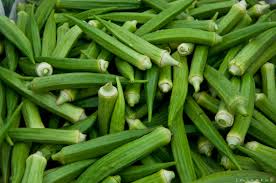
Scientific Name:Abelmoschus esculentus
LifeTime:10 to 12 weeks(produce)
Kingdom: Plantae
Clade: Tracheophytes
Order: Malvales
Family: Malvaceae
The species is a perennial, often cultivated as an annual in temperate climates, often growing to around 2 metres (6.6 ft) tall. As a member of the Malvaceae, it is related to such species as cotton, cocoa, and hibiscus. The leaves are 10–20 centimetres (3.9–7.9 in) long and broad, palmately lobed with 5–7 lobes. The flowers are 4–8 centimetres (1.6–3.1 in) in diameter, with five white to yellow petals, often with a red or purple spot at the base of each petal. The pollens are spherical with approximately 188 microns diameter. The fruit is a capsule up to 18 centimetres (7.1 in) long with pentagonal cross-section, containing numerous seeds. Abelmoschus esculentus is cultivated throughout the tropical and warm temperate regions of the world for its fibrous fruits or pods containing round, white seeds. It is among the most heat- and drought-tolerant vegetable species in the world and will tolerate soils with heavy clay and intermittent moisture, but frost can damage the pods. In cultivation, the seeds are soaked overnight prior to planting to a depth of 1–2 centimetres (0.39–0.79 in). It prefers a soil temperature of at least 20 °C (68 °F) for germination which occurs between six days (soaked seeds) and three weeks. Seedlings require ample water. The seed pods rapidly become fibrous and woody and, to be edible as a vegetable, must be harvested when immature, usually within a week after pollination.[12] Okra is available in two varieties, green and red. Red okra carries the same flavor as the more popular green okra and differs only in color. When cooked, the red okra pods turn green. The most common disease afflicting the okra plant is verticillium wilt, often causing a yellowing and wilting of the leaves. Other diseases include powdery mildew in dry tropical regions, leaf spots, and root-knot nematodes.
Okra is an allopolyploid of uncertain parentage (proposed parents include Abelmoschus ficulneus, A. tuberculatus and a reported "diploid" form of okra). Truly wild (as opposed to naturalised) populations are not known with certainty and the species may be a cultigen. The geographical origin of okra is disputed, with supporters of South Asian, Ethiopian and West African origins. The Egyptians and Moors of the 12th and 13th centuries used the Arabic word for the plant, bamya, suggesting it had come into Egypt from Arabia, but earlier it was probably taken from Ethiopia to Arabia. The plant may have entered southwest Asia across the Red Sea or the Bab-el-Mandeb straight to the Arabian Peninsula, rather than north across the Sahara, or from India. One of the earliest accounts is by a Spanish Moor who visited Egypt in 1216 and described the plant under cultivation by the locals who ate the tender, young pods with meal.[10] From Arabia, the plant spread around the shores of the Mediterranean Sea and eastward. The plant was introduced to the Americas by ships plying the Atlantic slave trade[11] by 1658, when its presence was recorded in Brazil. It was further documented in Suriname in 1686. Okra may have been introduced to southeast